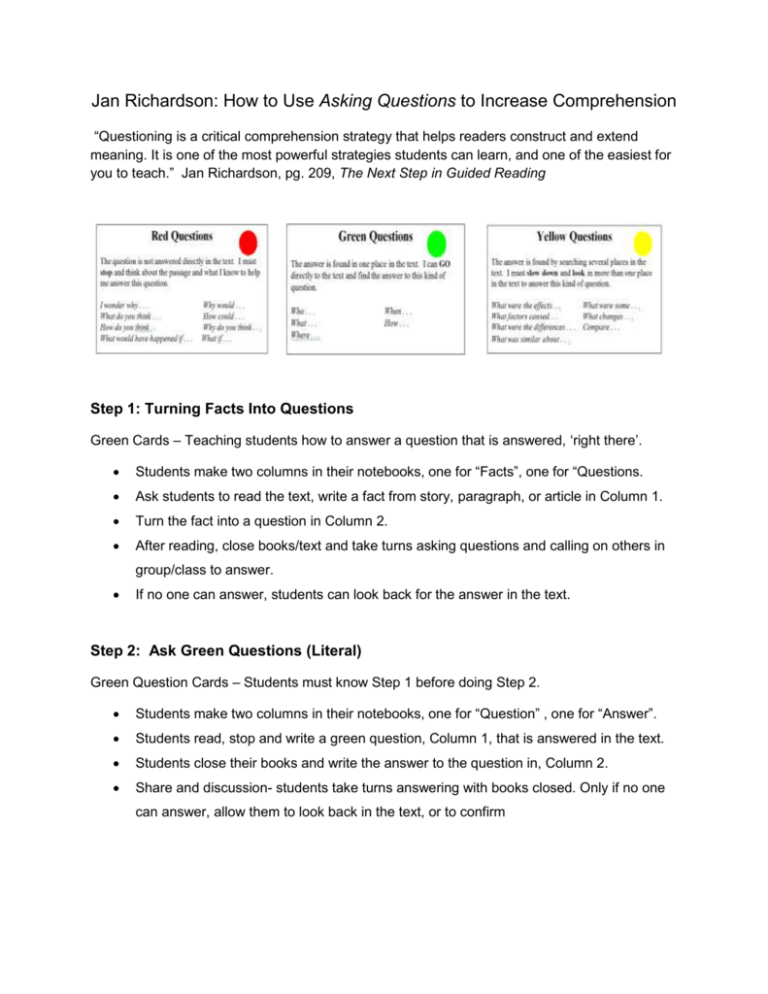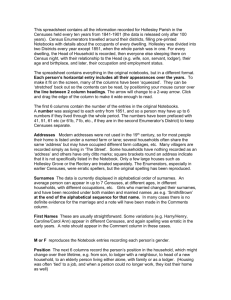Reading Comprehension: Questioning Strategies
advertisement

Jan Richardson: How to Use Asking Questions to Increase Comprehension “Questioning is a critical comprehension strategy that helps readers construct and extend meaning. It is one of the most powerful strategies students can learn, and one of the easiest for you to teach.” Jan Richardson, pg. 209, The Next Step in Guided Reading Step 1: Turning Facts Into Questions Green Cards – Teaching students how to answer a question that is answered, ‘right there’. Students make two columns in their notebooks, one for “Facts”, one for “Questions. Ask students to read the text, write a fact from story, paragraph, or article in Column 1. Turn the fact into a question in Column 2. After reading, close books/text and take turns asking questions and calling on others in group/class to answer. If no one can answer, students can look back for the answer in the text. Step 2: Ask Green Questions (Literal) Green Question Cards – Students must know Step 1 before doing Step 2. Students make two columns in their notebooks, one for “Question” , one for “Answer”. Students read, stop and write a green question, Column 1, that is answered in the text. Students close their books and write the answer to the question in, Column 2. Share and discussion- students take turns answering with books closed. Only if no one can answer, allow them to look back in the text, or to confirm Step 3: Ask Red Questions (Inferential) Interpretive Level Red Question Cards – Answers are not found in the text As students read, they ask (and write down) questions that begin with Red Card words, I wonder why.., How could..., Why would…., What if….What would happen if…. Guide students to ask questions that could be answered using background knowledge and information in the text. Model for them. When sharing, encourage students to think of more than one logical answer. After a few days/rounds of practice of writing just the red questions, require them to write answers in their notebooks. Encourage divergent thinking and different answers. Step 4: Ask Yellow Questions (Complex) Yellow Question Cards – Readers use different parts of the text to ask and answer questions Questions include, cause/effect, compare/contrast and idea-to-examples. Students are proficient at green and red questions before doing yellow questions. Teacher models, students practice. (Review cause/effect pgs. 225-227) Step 5: Combine Questions Students must know how to ask at least two kinds of questions to combine questions/strategies. Ask Green and Red Questions: Students make two columns in their notebooks. As they read, they must think of a green question for column 1 and red for column 2. Early/fast finishers make more questions for the group. During sharing, students share one question. Before the group answers, students decide if it’s a green or red question. Question-Answer & Connection or Prediction Three column framework Students write a question (red, yellow, green) in Column 1, answers in Column 2 and a prediction in Column 3. At the Evaluative Level in Fiction or Non-Fiction, students think of a question that asks for an opinion or a judgment. (Why do you think? Do you agree (disagree) that…? Do you think it was right for …?) Created by Ellen Lewis, Reading Teacher, Westlawn ES, VA








